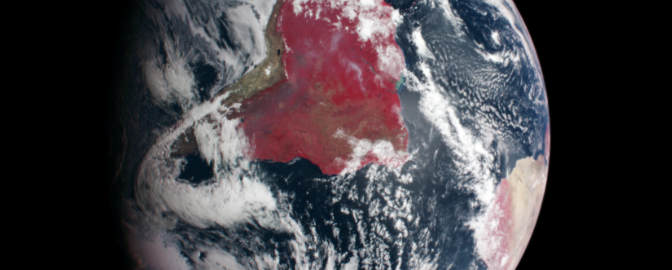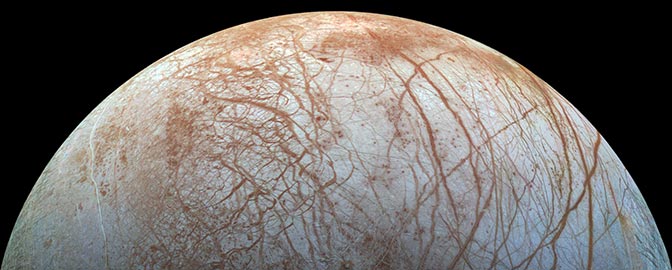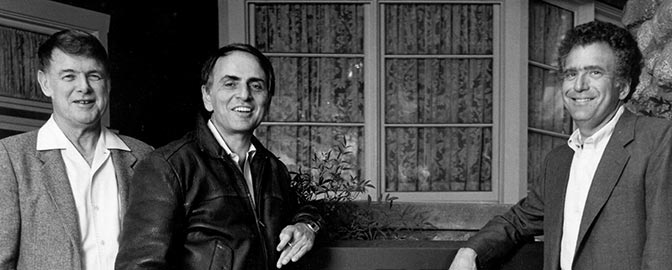EELS and the future of exploration
How artificial intelligence could traverse other worlds

Written by
Kate Howells
Public Education Specialist, The Planetary Society
March 10, 2025
If you want to send a robotic explorer to an unexplored planet or moon, how should you design it to move around its environment? The future of exploration may involve letting the robot decide for itself.
This is one of the core principles of NASA’s EELS (Exobiology Extant Life Surveyor) project. This technology demonstration (not yet an approved mission) was first designed with the challenges of exploring Saturn’s moon Enceladus in mind. Data from NASA’s Cassini spacecraft hinted at a subsurface ocean of liquid water beneath the icy crust, sometimes spewing out into space through cracks around the moon’s south pole. In that ocean, conditions may be favorable to life. But sending a spacecraft to probe those icy depths would be challenging. Enceladus is extremely far away, making communication difficult, and we don’t have a detailed understanding of its surface environment.
EELS aims to address a challenge like this through artificial intelligence coupled with an innovative design. The robot’s snakelike body is made of multiple segments, each capable of moving independently to enable propulsion, traction, and grip. EELS can change its shape and how it moves to adapt to whatever environmental conditions it encounters. Crucially, it doesn’t rely on commands from Earth to make those decisions; EELS maps its surroundings using stereo cameras and lidar and then uses artificial intelligence to decide how best to get around.
The team behind EELS believes that its autonomy and adaptability represent a paradigm shift in robotic exploration. Hiro Ono, EELS principal investigator, describes this as “Robotic Exploration 3.0.” In November, Ono and graduate student Morgan Cable spoke with Planetary Radio host Sarah Al-Ahmed about the project, the role artificial intelligence plays in it, and how the future of space exploration might evolve.
First of all, the big question: Given the challenges, why explore a distant, unknown environment like Enceladus at all?
This transcript has been edited for length and clarity.
Morgan Cable: Enceladus is just such a fascinating world. Every place in our Solar System is unique and interesting in its own right. But for me, Enceladus holds such magic because it has this liquid water ocean and this tortured surface with cracks in it, and it is the one place where we know that water is coming straight from that ocean into space in a way that we can access it with technology today.
From an astrobiology perspective, this is one of our first real opportunities to test this question: If you have the ingredients for life — water, chemical building blocks, and energy — and you mix them together and wait, does life form? This is a place where we can go and test this. We call this civilization-level science because when you discover life elsewhere for the first time in human history, you only get to do that once. And we have the technology to detect life on another world right now. We just have to get there. We have to go.
Sarah Al-Ahmed: Because the terrain of Enceladus is complicated, if we want to find life, we’re going to have to find ways to get down into those cracks and potentially sample things in the water. And that is a colossal challenge to tackle.
MC: Life is not likely to be just sitting out in the open on a planetary surface where it’s exposed to the extreme conditions of space. Chances are it’s going to be in those hard-to-reach places: under a rock, in a crevasse, down in one of these subsurface liquid water oceans. And developing technology that can tackle those challenges gives us access to these places that previously were so far out of reach.
SAA: That brings us to EELS.
MC: Picture an anaconda-size robot designed to navigate the features on the surface of an icy world and then get down into a vent — a crack in that ice shell. And there, stuff is shooting out at 200-300 kilograms (440-660 pounds) a second. This robot will need to push against the walls of that ice shaft and move down to get into the really exciting environment: that liquid water ocean.
Hiro Ono: There are many reasons that this is challenging, but I would say the greatest challenge is the uncertainty, the unknowns. We’ve sent 10 spacecraft to Mars, knowing a lot beforehand about the regions where we landed and explored. But the best resolution we have on Enceladus is about 6 meters (20 feet) per pixel and only around very limited regions. We don’t know, for example, what the surface topography is or what the geometry of the vents is. We still don’t know how strong the jets are. It’s really, really hard to design an explorer without knowing what the environment is.
That’s why EELS is so different from rovers, in that its snakelike design gives it many ways of moving around. If something unexpected happens, it can change the mode of locomotion and figure out the best way to interact with the environment.
SAA: There are two things going on here. One is the actual physical design of this object, but there’s also the brain behind this technology. EELS uses artificial intelligence to figure out how to move around its environment based on the conditions it encounters. Hiro, you’ve spoken before about the idea of “Space Exploration 3.0.” Can you talk a little bit about this framework for understanding space exploration and how this technology represents a new phase forward?
HO: The way we explore planetary surfaces has changed over time. In the ’60s, NASA sent a bunch of spacecraft to the Moon as a precursor to Apollo. It was basically trial and error to learn what worked. And that was a reasonable way to learn how to get to the Moon because the Moon is nearby. You can get there in three days. So we could call that “Robotic Space Exploration 1.0”: trial and error.
Mars is six to seven months away, and the launch window opens up only every 26 months. Now you cannot do trial and error and wish for the best, right? You need to be sure that what you’re going to do will work, so we changed the mode.
We got more cautious; we incrementally learned about the environment and refined our capabilities, starting with flybys, orbiters, landers, and then rovers. Then, we knew enough to build Curiosity and Perseverance — super complex robots — and now we are designing an even more complex Mars Sample Return campaign. That’s “Robotic Space Exploration 2.0.” And that’s how we were so successful on Mars in the past few decades.
But we can’t extrapolate that model to the outer Solar System, simply because it takes much too long to get to those destinations. So that’s where “Robotic Space Exploration 3.0” comes in. It involves a more intelligent, more adaptive robot capable of diving into a highly unknown environment — a robot that can learn by itself [and] adapt by itself to robustly explore the environment.

SAA: A huge benefit of this kind of technology is that it can be used for many different destinations since it adapts itself to new environments. What could this mean for the future of space exploration? And how has EELS moved us toward this future?
MC: The planets and moons of the outer Solar System are so diverse and fascinating. And each time we send a spacecraft somewhere new, we learn more than we could have possibly imagined. Just think about if we had dedicated missions for each of the worlds around Jupiter, Saturn, Uranus, Neptune, and beyond, as well as the asteroid belt. There are so many exciting worlds to explore, and each one is deserving of its own mission.
One of the coolest things I’ve discovered working on the EELS project is that the snake has already grown legs in a certain way. Some of the technologies that we developed, particularly some of the autonomy technologies as well as a few of the others on the engineering side, are being incorporated into other mission concept developments and other engineering and robotics projects at JPL. I definitely hope to see an EELS-like robot on another world in my lifetime. I really think that would be incredible.
SAA: And we should be clear: There is no mission currently planned to go to Enceladus. But if we want that mission to exist, we need to build the technologies to do it.
HO: I think a mission to the subsurface ocean of icy moons will happen. Why? Because there’s this fundamental question that we want to answer. This is probably one of the oldest questions of humankind. What I don’t know is how soon it is going to happen. And I think it’s fair to say that we’re making a great leap in the technologies needed for that. Whatever spacecraft actually goes down into an icy moon’s ocean may or may not look exactly like EELS. But our contributions will be there.
MC: NASA’s mission has always been driven by the science. As long as there is NASA, as long as we are still guided by science and by looking up at the night sky and wondering, as long as that is still our guiding light, our candle in the dark, we will be sending spacecraft out there to these ocean worlds and exploring their watery depths.
SAA: You’ve just got to dare enough mighty things, one step at a time.
MC: Or one slither at a time if you’re a snake.
Support our core enterprises
Your gift today will go far to help us close out the year strong and keep up our momentum in 2026.
DonateThe Planetary Report • March Equinox
Help advance space science and exploration! Become a member of The Planetary Society and you'll receive the full PDF and print versions of The Planetary Report.


 Explore Worlds
Explore Worlds Find Life
Find Life Defend Earth
Defend Earth



